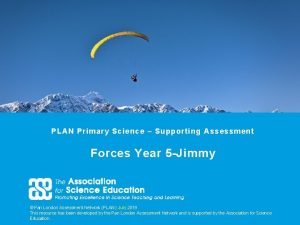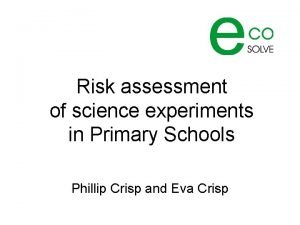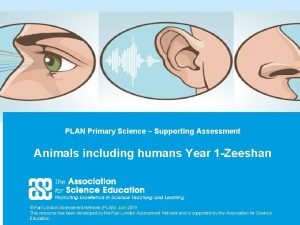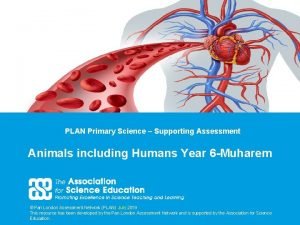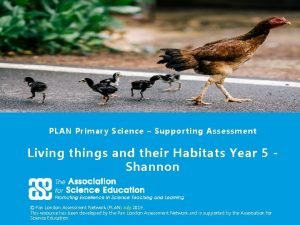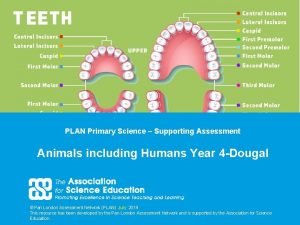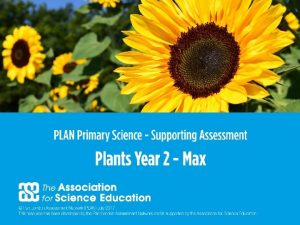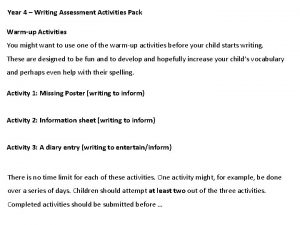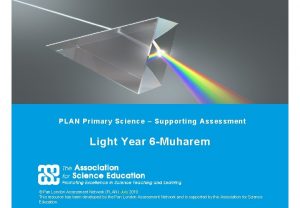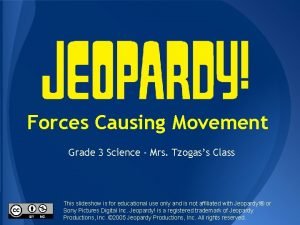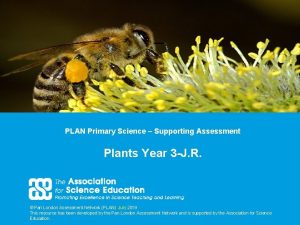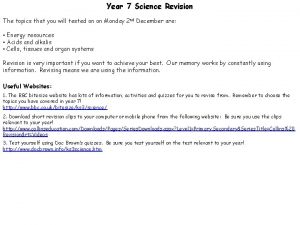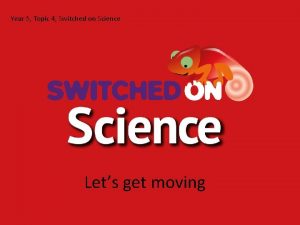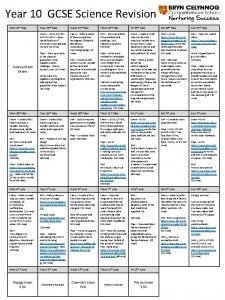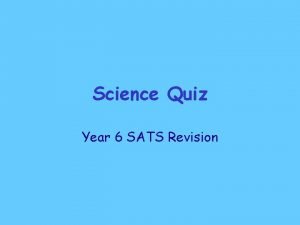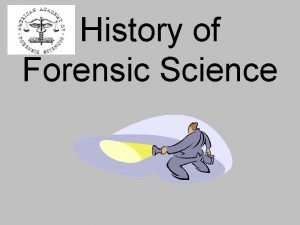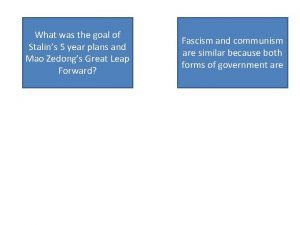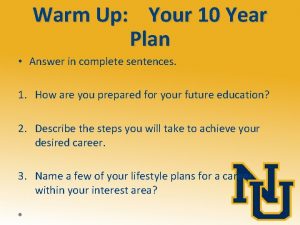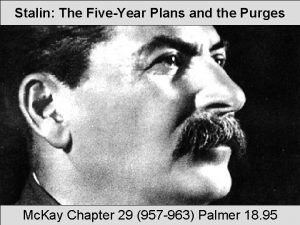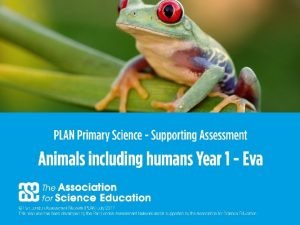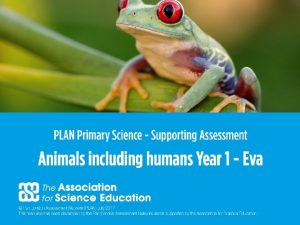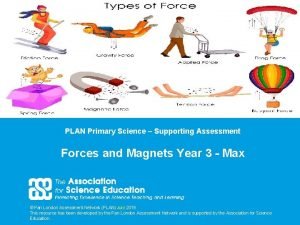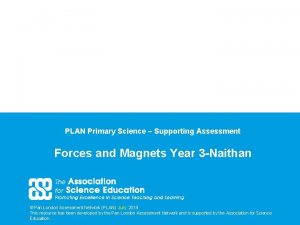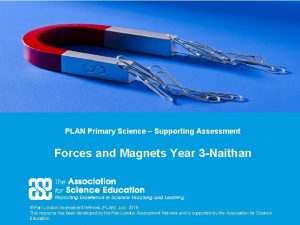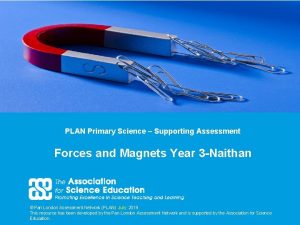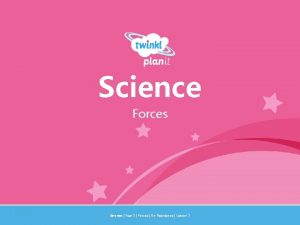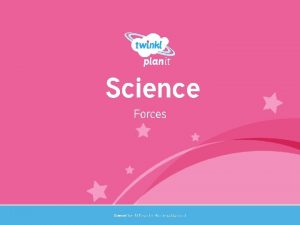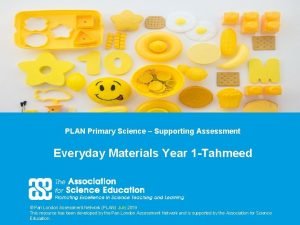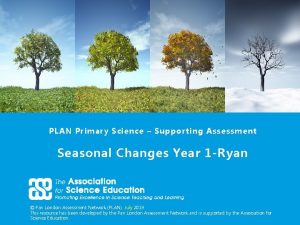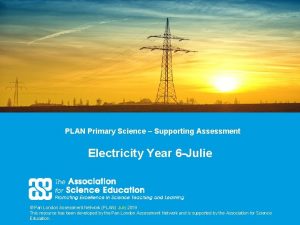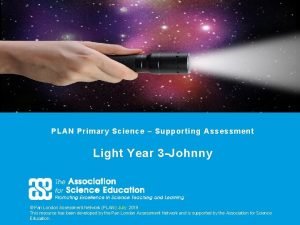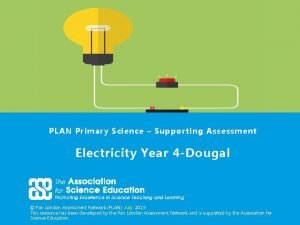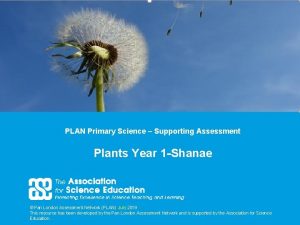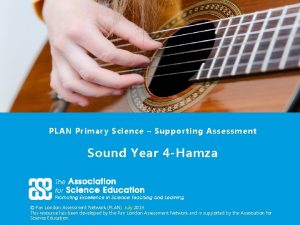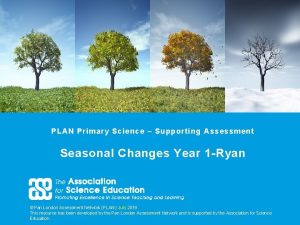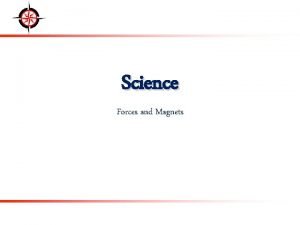PLAN Primary Science Supporting Assessment Forces Year 5



































- Slides: 35

PLAN Primary Science – Supporting Assessment Forces Year 5 -Jimmy © Pan London Assessment Network (PLAN) July 2019 This resource has been developed by the Pan London Assessment Network and is supported by the Association for Science 1 Education.

PLAN Primary Science - Supporting Assessment PLAN Primary Science is a set of resources produced to enable teachers to have a clearer understanding of National Curriculum expectations for meeting the standard. Annotated collections of children’s work provide examples of what working at the expected standard for primary science might look like for the knowledge and conceptual understanding statements of the programmes of study (POS). It is not the intention of these resources to specifically exemplify the working scientifically statements. However, aspects of working scientifically have been shown as an integral part of the teaching and learning of the knowledge and concepts. The resources provided have been cross moderated multiple times before publishing so that they can be used with confidence by teachers and subject leaders. Each collection of work shows one example of how a pupil has met National Curriculum statements for a particular area of content but these are not intended to be the definitive way of teaching these statements. 2

Structure of the resources Each resource contains the relevant National Curriculum statements for the unit of work and prior learning, a planning matrix, annotated work and a summary sheet. The matrix provides an interpretation of the key learning of the National Curriculum statements, and suggestions of key vocabulary. In order to be meet the expectations pupils must firstly understand the key concept and then be provided with opportunities to apply that knowledge. This is a key planning tool. Key Learning Secure Possible Evidence Show Overview paragraph describing understanding of a curriculum concept by using scientific Key vocabulary – list of words vocabulary correctly Possible ways to demonstrate key learning, particularly correct usage of vocabulary Apply knowledge in familiar related contexts Possible ways to demonstrate that a pupil has gone beyond recall of facts and can apply the key learning, for example using the vocabulary and basic principles to produce explanations, usually within Working Scientifically contexts. Suggestions of contexts to use. 3

Contents of the materials Please note: The NC statements for each topic area for the relevant year group are stated on the slide. Only the statements in bold on that slide have been exemplified. In these cases the teachers have chosen to split the statements within the topic area to teach at different times. The prior NC statements relevant to the topic area are also stated and use to determine pupils’ knowledge at the start of the unit. Each slide has been annotated with coloured text. Please see key below: Red Commentary to explain how evidence meets/does not meet NC statements Blue Commentary to highlight features of working scientifically Green Pupil Speak Grey Other relevant information eg. vocabulary used 4

Prior Learning - Year 3 Statements Pupils should be taught to: • compare how things move on different surfaces (3 -Forces) • notice that some forces need contact between two objects, but magnetic forces can act at a distance (3 -Forces) • observe how magnets attract or repel each other and attract some materials and not others (3 -Forces) • compare and group together a variety of everyday materials on the basis of whether they are attracted to a magnet, and identify some magnetic materials (3 -Forces) • describe magnets as having two poles (3 -Forces) • predict whether two magnets will attract or repel each other, depending on which poles are facing (3 -Forces) 5

Year 5 Statements Year 5 statements Pupils should be taught to: • explain that unsupported objects fall towards the Earth because of the force of gravity acting between the Earth and the falling object (5 -Forces) • identify the effects of air resistance, water resistance and friction, that act between moving surfaces (5 -Forces) • recognise that some mechanisms, including levers, pulleys and gears, allow a smaller force to have a greater effect (5 -Forces) 6

Later Statements Pupils do not need to be taught content they will learn in later year groups. They can be challenged by applying the content for their year group in broader contexts. Pupils in Key Stage 3 should be taught about: • forces as pushes or pulls, arising from the interaction between two objects • using force arrows in diagrams, adding forces in one dimension, balanced and unbalanced forces • moment as the turning effect of a force • forces: associated with deforming objects; stretching and squashing – springs; with rubbing and friction between surfaces, with pushing things out of the way; resistance to motion of air and water • forces measured in newtons, measurements of stretch or compression as force is changed

Key learning Possible evidence Shows understanding of a concept using scientific vocabulary correctly A force causes an object to start moving, stop moving, speed up, slow down or change direction. Gravity is a force that acts at a distance. Everything is pulled to the Earth by gravity. This causes unsupported objects to fall. Air resistance, water resistance and friction are contact forces that act between moving surfaces. The object may be moving through the air or water or the air and water may be moving over a stationary object. A mechanism is a device that allows a small force to be increased to a larger force. The pay back is that it requires a greater movement. The small force moves a long distance and the resulting large force moves a small distance, e. g. a crowbar or bottle top remover. Pulleys, levers and gears are all mechanisms, also known as simple machines. Key vocabulary Force, gravity, Earth, air resistance, water resistance, friction, mechanisms, simple machines, levers, pulleys, gears Can demonstrate the effect of gravity acting on an unsupported object Can give examples of friction, water resistance and air resistance Can give examples of when it is beneficial to have high or low friction, water resistance and air resistance Can demonstrate how pulleys, levers and gears work Applying knowledge in familiar related contexts, including a range of enquiries Investigate the effect of friction in a range of contexts e. g. trainers, bath mats, mats for a helter-skelter Investigate the effects of water resistance in a range of contexts e. g. dropping shapes through water, pulling shapes e. g. boats along the surface of water Investigate the effects of air resistance in a range of contexts e. g. parachutes, spinners, sails on boats Explore how levers, pulleys and gears work Make a product that involves a lever, pulley or gear Create a timer that uses gravity to move a ball Research how the work of scientists such as Galileo Galilei and Isaac Newton helped to develop theory of gravitation Can explain the results of their investigations in terms of the force, showing a good understanding that as the object tries to move through the water or air or across the surface, the particles in the water, air or on the surface slow it down Can demonstrate clearly the effects of using levers, pulleys and gears SECURE Assessment guidance

Initial activity to engage prior learning The children were shown a video clip that showed a range forces in action including a spacecraft being launched, astronauts moving in space, sprinters on an athletics track, an elephant pulling a log, a bird landing, a car travelling over a rough surface, a stunt car, and a boat being launched http: //www. bbc. co. uk/learningzone/clips/forces-in-action-nonarration/1601. html Some still images taken from the video were displayed on the board for the children to discuss how they were linked. There was always something moving. The car was moving but got stopped when it hit the wall. The acorn wasn’t moving and then did. The windmills are turning all the time and the elephant keeps moving. The elephant is pulling the log. The wind is pushing the windmills round. Jimmy describes the movement of the objects and recognises that a push or pull is linked to this. He does not name any specific forces. 9

Odd one out • explain that unsupported objects fall towards the Earth because of the force of gravity acting between the Earth and the falling object The children were shown three different images from the video clip and asked to talk about which one they thought was the odd one out and why. The middle one is the only one with people in it. The two people are moving differently. One is in the air and one is on the ground. The bottom one is a bit of a plant. The teacher then dropped a ball and asked them to think about how the images were linked to this. They are all falling down. Jimmy recognises that objects fall to the ground but does not use the word gravity. 10

Odd one out • explain that unsupported objects fall towards the Earth because of the force of gravity acting between the Earth and the falling object The teacher then introduced gravity as a force acting between the Earth and an object pulling it down. They were shown a moonwalking clip to show the impact of reduced gravity and then asked to consider the idea of ‘A world without gravity’ and identify positives and negative consequences. It would be really fun to float around. Everything would need to be tied down to the ground. You would have to use baby cups with lids. How would you go to the toilet? The children were then shown a globe with some lego people stuck on and asked to think about what would happen to a ball that each person threw. After discussions they then drew this. Jimmy shows the ball falling back to Earth wherever it is on the Earth’s surface. His comment shows that he recognises that gravity reaches a long way. At this point the children had not learnt about the solar system and he is only considering the gravity of Earth, but this is appropriate for security in this statement. He links the concept to a magnetic pull although this is incorrect it shows good thinking. 11

Using forcemeters • explain that unsupported objects fall towards the Earth because of the force of gravity acting between the Earth and the falling object The children were given a set of forcemeters to look at to consider how they were the same and different. They noticed that they all had springs but they were different thicknesses. They all had numbers on a scale but this was different. They all had identical hooks and handles. The teacher then demonstrated how to take a measurement by putting an object is a hole punched plastic wallet and hanging it on the hook. It was highlighted that it needed to be kept steady and for it to be held at eye level. The children then took measurements with a partner. Jimmy and his partner take precise readings choosing the most appropriate forcemeter depending on the size of the force. When asked what he was measuring, Jimmy said – The force that I need to keep it up to stop gravity pulling it down. Jimmy talks confidently about gravity. 12

Investigating friction – moving trainers on different surfaces • compare how things move on different surfaces (year 3 statement) • identify the effects of air resistance, water resistance and friction, that act between moving surfaces The children were shown the image and asked to think about why the boy was finding it hard to pull the girl and the dog. They are in a sledge so they should be on snow, but they are on grass. It would be easier to pull them on snow. Jimmy shows an awareness that objects move differently on different surfaces (year 3 statement secure). He does not use the word friction. The teacher then introduced friction as a force acting when one solid moves over another solid. Jimmy uses appropriate subject knowledge to make a prediction. He also identifies a variable that should be controlled but does not make it explicit that they should use the same shoe. 13

Investigating friction – moving trainers on different surfaces (contd. ) • compare how things move on different surfaces (year 3 statement) • identify the effects of air resistance, water resistance and friction, that act between moving surfaces Jimmy draws a table to record his results but does not give the second column a heading. Jimmy uses his results to draw conclusions. He identifies a variable that they did not control – the difference in temperature between inside and outside. Jimmy links the ease of movement with the texture of the surface recognising that the trainer was more difficult to move on the uneven surface of the tarmac. He still does not 14 link this to friction.

Investigating friction – rolling cars on different surfaces • identify the effects of air resistance, water resistance and friction, that act between moving surfaces The children carried out a second investigation into friction in order to apply their learning. They were given a car and a ramp and asked to design their own investigation. Jimmy uses his learning from the previous investigation when making his prediction. He identifies and controls some variables. Key vocabulary used - friction Jimmy now uses the word friction when describing how the car will move on different surfaces. 15

Investigating friction – rolling cars on different surfaces (contd. ) • identify the effects of air resistance, water resistance and friction, that act between moving surfaces Jimmy draws a table to record his results now with headings for both columns. He does not consider taking repeat readings. In the writing below Jimmy identifies causal relationships in his results. Jimmy is secure in identifying the effects of friction between two surfaces. 16

Thought enquiry – imagine a world without friction • identify the effects of air resistance, water resistance and friction, that act between moving surfaces The children were shown the image and asked to discuss what was happening. The polar bear is sliding on his back. The ice is smooth so there is less friction between the ice and his back which is helping him to slide. When he wants to walk he has claws which dig in the ice. This increases the friction. Jimmy talks confidently about friction acting between two surfaces. The children were then asked to discuss living in a world without friction. We could slide everywhere, but we would keep crashing because we couldn’t stop. We wouldn’t need cars and things with engines so it would be better for the environment. You would have to put objects down really carefully because otherwise they would keep moving. Friction is really important. Jimmy has a secure understanding of friction and can apply it in different contexts. 17

Introduction to air resistance • identify the effects of air resistance, water resistance and friction, that act between moving surfaces The teacher held a parachute in the air and asked what would happen if she let it go. It will be pulled to the ground by gravity. She then dropped two identical parachutes at the same time but one was scrunched up and the other was held open and asked the children to make observations. The scrunched up one fell more quickly. It went straight down and it made more noise when it hit the floor. The air holds the open one up so it comes down more slowly. It floats down. The teacher introduced air resistance as a force that slows an object down as it moves through air as the air particles block the path of the object. She then dropped two parachutes with different sized canopies and asked the children to make observations. The bigger one fell more slowly as there is more air under the canopy slowing it down. Although Jimmy is not yet using the word air resistance, his comment shows an understanding of the concept. This is not yet sufficient to be secure. 18

Introduction to air resistance (contd. ) • identify the effects of air resistance, water resistance and friction, that act between moving surfaces The children were shown three images and asked to think about which was the odd one out and why. The words gravity and air resistance were displayed on the board as prompts. The plane does not fall to the ground like the other two. The engine keeps it in the air. Gravity can’t win over the engine. The sycamore seeds spin as they fall to the ground Jimmy makes relevant comments about the images which include gravity. He does not identify that the sycamore seed and parachute have high resistance and the aeroplane has low air resistance. 19

Introduction to air resistance (contd. ) • identify the effects of air resistance, water resistance and friction, that act between moving surfaces The children were asked to talk about a parachute jump including if possible the words gravity and air resistance. When the man jumps out of the plane he will fall down as gravity is pulling him. While his parachute is closed he will fast as there is not much air resistance. When the parachute opens, this make the air resistance bigger as there is more air slowing the parachute down. He will fall more slowly and hopefully not break his legs! Jimmy shows a good understanding of the effect of air resistance on the man falling 20

Concept cartoon • identify the effects of air resistance, water resistance and friction, that act between moving surfaces The children were asked to discuss the concept cartoon. I think spinning will slow the paper down like the sycamore seed. The more it spins the slower it will go. I think if it is bigger it will go more slowly as there is more air resistance. Jimmy uses his prior observations when making predictions. Jimmy now uses the word air resistance and understands the effect this will have on the paper falling. 21

Air resistance investigation • identify the effects of air resistance, water resistance and friction, that act between moving surfaces Based on the spinner the children were asked to plan an investigation to answer their own question. Jimmy’s group chose to investigate the effect of folding the spinner to make the body of the spinner different lengths. Each time he makes a larger fold so the length of the spinner decreases. Jimmy’s question relates to the speed of the spinner, but he then goes on to measure time. He uses a stopwatch to measure the time each spinner takes to fall, takes repeat readings and records these in a table provided. He calculates the average for each set of results. 22

Air resistance investigation (contd. ) • identify the effects of air resistance, water resistance and friction, that act between moving surfaces Jimmy reviews his results and comments on the pattern in his data. Jimmy associates the shape of the object with the amount of air resistance and recognises that this can have an impact on how it falls. The teacher noticed that there was no significant difference in the results and asked Jimmy about this. In my table the numbers vary a lot for each repeat reading which is why it is good that I tried it more than once. The averages are very close together, only a fraction of a second different. Now I come to think of it, this is nothing. It was a bit rubbish. I don’t think I proved anything. 23 With help Jimmy identifies that his data is not sufficient to answer his question.

Air resistance investigation • identify the effects of air resistance, water resistance and friction, that act between moving surfaces Other groups carried out different investigations. This group chose to investigate what happened when additional paper clips were added. 1. 41 s 2. 073 s 1. 216 s This question implies that they will be timing the fall rather than looking at the speed. 1. 256 s 1. 096 s The pattern in the results is not as simple as this. It is important to note that two objects of the same shape but different weights will land at the same time. The heavier object does not fall faster. Adding weight does not affect air resistance, but in this case it may affect the way the spinner rotates which will then affect 24 the air resistance. This should be avoided in year 5 as it is beyond the curriculum.

Introduction to air resistance • identify the effects of air resistance, water resistance and friction, that act between moving surfaces Outside the children compared throwing a rugby ball and a javelin. Jimmy uses the word streamlined to describe the javelin. The teacher picks up on this is a future water resistance lesson. Jimmy applies his knowledge of air resistance in another familiar context. He is secure with this concept. 25

Investigating resistance in different liquids • identify the effects of air resistance, water resistance and friction, that act between moving surfaces Four bowls were passed around the class with a spoon in each. One was empty and the others contained water, oil or glue. The children were invited to stir each to see how they compared. They found that the glue was the hardest to stir but the water, oil and empty bowl were easy to stir. They were asked to think about why the glue was harder to stir. Because it is thicker and it makes it harder to move the spoon through it. The teacher introduced the word resistance as a force that slows an object down. She then asked them to discuss the concept cartoon. I don’t think the penny will float even in the glue. It will fall to the bottom in all of them but will take longer in the glue because it will slow it down. Jimmy uses his first test results to make a prediction for this next investigation. Jimmy does not include the word resistance. 26

Investigating resistance in different liquids (contd. ) • identify the effects of air resistance, water resistance and friction, that act between moving surfaces The teacher demonstrated this investigation as it would have involved large quantities of the different liquids for this to be carried out by the children. The children were given stopwatches to take the measurements. My prediction was right. The penny sank in all of them. It fell the fastest in the water, then the oil and then the glue. There was more resistance in the glue slowing it down. Jimmy now uses the word resistance to explain his results. 27

Discussing the effect of water resistance • identify the effects of air resistance, water resistance and friction, that act between moving surfaces The children were shown two images of Olympic athletes and asked to discuss the questions. Will Usain Bolt run faster in the water or on land? Why? Is it faster to run or swim in the water? Why? There is more resistance in water that will slow him down. I think even if Bolt was running in the water the swimmer would beat him. It is really hard to run in the water. The teacher introduced the term water resistance as the force that slows down objects moving through water. She also asked Jimmy to talk about streamlining. You are more streamlined when you are swimming because your head cuts through the 28 water and your body follows.

Introduction to gears, levers and pulleys • recognise that some mechanisms, including levers, pulleys and gears, allow a smaller force to have a greater effect The children were shown a range of pictures and asked to think about which ones they might group together. Together they decided to put turning ones together and lifting ones together. There was discussion about whether the wheel barrow and the man lifting the box should go in this group or not because whilst they were used for lifting they were not lifting in the same way. The turning ones all have wheels that join together. Those are the gears on the bike. The thing that is being lifted is on a rope which goes round something. The teacher then showed some video clips about levers, gears and pulleys to introduce the children to their functions and some additional vocabulary. 29

Exploring gears • recognise that some mechanisms, including levers, pulleys and gears, allow a smaller force to have a greater effect During a carousel activity the children were given the chance to explore gears, pulleys and levers. They were then shown images of other examples and asked to draw and annotate these to show their understanding. Jimmy understands that consecutive gears turn in opposite directions and that the speed of the gear depends on its size. The gears next to each other turn in the opposite direction. The small gears turn faster than the big gears. 30

Exploring levers • recognise that some mechanisms, including levers, pulleys and gears, allow a smaller force to have a greater effect It is easier to lift the weight if you push down on the end of the ruler. That is because the lever is longer. Learning from the exploration was then applied to opening a tin. Jimmy understands that using a lever enables the tin to be opened with a smaller force. 31

Exploring pulleys • recognise that some mechanisms, including levers, pulleys and gears, allow a smaller force to have a greater effect When you add another pulley you need less force to lift the object, but you need a much longer bit of rope or string as you need to pull further. Whilst these three annotated diagrams do not show a complete understanding of the use of mechanisms to allow a smaller force to have a greater effect, his comments whilst carrying out the exploration activities do show this understanding. 32

Checking on understanding of levers, gears and pulleys • recognise that some mechanisms, including levers, pulleys and gears, allow a smaller force to have a greater effect The children were shown the images from earlier and asked to talk about them again. The turning pictures are all gears. They turn at different speeds depending on how big they are. It makes it easier for you to cycle up hill. You have to push less hard on the pedals in a lower gear, but you go more slowly. The lifting ones are pulleys. You have to pull further on the rope when it is looped over more time, but it is easier to pull. The man is using a lever to lift the box. The longer the lever the easier it is. Jimmy understands the effect of using gears, levers and pulleys. 33

Overall Summary - Secure Jimmy understands that objects fall due to gravity pulling them down. He has carried out a number of investigations to explore friction, water resistance and air resistance and can explain the effect of these on moving objects. He has also explored levers, gears and pulleys and recognises that these enable a smaller force to have a greater impact. 34

Acknowledgements Slides 8, 9 and 10 – Images from BBC Learning Zone clips Slide 19 – Images from Hamilton Trust Slides 20, 26 and 27– Concept cartoon from Hamilton Trust 35
 Forces year 5
Forces year 5 Science risk assessment primary school
Science risk assessment primary school Plan primary science
Plan primary science Plan primary science
Plan primary science Plan primary science
Plan primary science Plan primary science
Plan primary science Plan primary science
Plan primary science My favorite subject is science แปลว่า
My favorite subject is science แปลว่า Fixation omission emphasis
Fixation omission emphasis Primary and supporting instruments
Primary and supporting instruments Define the resultant of unlike parallel forces
Define the resultant of unlike parallel forces The forces shown above are pushing/pulling forces
The forces shown above are pushing/pulling forces Intermolecular and intramolecular forces
Intermolecular and intramolecular forces Intermolecular forces vs intramolecular forces
Intermolecular forces vs intramolecular forces Inter vs intramolecular forces
Inter vs intramolecular forces Contact force
Contact force Net force
Net force Destructive process examples
Destructive process examples Fabulous forces
Fabulous forces School leavers poem
School leavers poem Writing assessment year 4
Writing assessment year 4 Light assessment year 6
Light assessment year 6 Grade 3 science forces
Grade 3 science forces Year 3 light
Year 3 light Plants planning year 3
Plants planning year 3 Year 7 science revision
Year 7 science revision Switched on science
Switched on science Year 10 science revision
Year 10 science revision Keeping healthy quiz
Keeping healthy quiz Calvin goddard contribution to forensic science
Calvin goddard contribution to forensic science Yellow magenta and cyan are the ___
Yellow magenta and cyan are the ___ What was the goal of stalin's 5 year plan
What was the goal of stalin's 5 year plan My 10 year plan.com
My 10 year plan.com Stalins five year plan
Stalins five year plan Stalin 5 year plan
Stalin 5 year plan Mathtv
Mathtv
